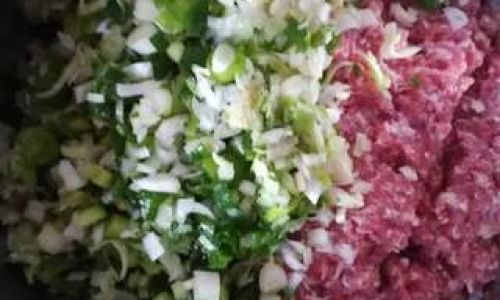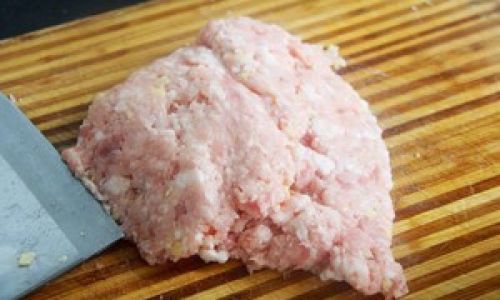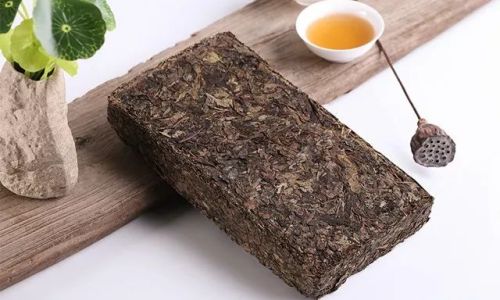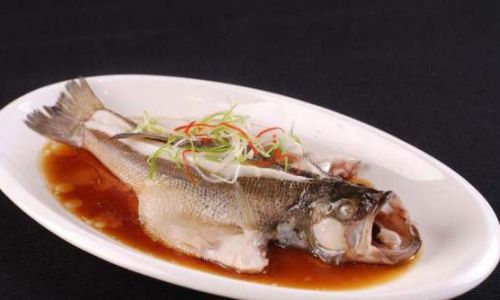Introduction
Baozi, often referred to as Chinese steamed buns, are a beloved staple in Chinese cuisine, cherished for their soft, fluffy texture and savory, aromatic fillings. Among the myriad variations, the pork and green onion filling stands out as a classic, beloved for its harmonious balance of umami-rich meat and the fresh, pungent kick of scallions. Crafting the perfect baozi requires precision, patience, and an understanding of the interplay between ingredients and technique. This article delves into the intricacies of creating an unforgettable pork and green onion baozi filling, from selecting the finest ingredients to mastering the art of steaming. Whether you are a novice cook or a seasoned home chef, this guide will equip you with the knowledge to elevate your baozi-making skills to new heights.
The Essence of Pork and Green Onion Filling
The allure of pork and green onion baozi lies in its simplicity and depth of flavor. The filling combines ground pork, typically a blend of pork shoulder and belly for optimal fat content, with finely chopped green onions, ginger, garlic, and a medley of seasonings. The result is a juicy, aromatic mixture that bursts with flavor when steamed. The key to success hinges on achieving the right balance of seasonings, ensuring the meat is tender, and the green onions retain their vibrant color and crisp texture.
Ingredients: A Symphony of Flavors
To create a memorable pork and green onion filling, gather the following ingredients:
- Ground Pork (500g): Opt for a mix of pork shoulder (40%) and pork belly (60%) for a rich, tender texture. Avoid lean cuts, as they may result in a dry filling.
- Green Onions (150g): Fresh, crisp scallions with vibrant green stems and white bulbs. Wash and dry thoroughly before chopping.
- Ginger (15g): Finely minced or grated to add a subtle warmth.
- Garlic (10g): Minced for aromatic depth.
- Soy Sauce (2 tbsp): Use light soy sauce for saltiness without overwhelming the meat’s natural flavor.
- Shaoxing Wine (1 tbsp): A rice wine that imparts a delicate sweetness and neutralizes any gamey notes in the pork.
- Sesame Oil (1 tsp): Toasted sesame oil adds a nutty aroma.
- White Pepper (1/4 tsp): For a mild, floral heat.
- Sugar (1 tsp): Balances the saltiness and enhances umami.
- Salt (1/2 tsp): Adjust to taste, but err on the side of caution as soy sauce adds saltiness.
- Cornstarch (1 tbsp): Acts as a binder, ensuring the filling remains moist and cohesive.
- Chicken Broth or Water (2-3 tbsp): To hydrate the filling and prevent dryness.
Preparing the Filling: A Step-by-Step Process
Mincing the Pork
Begin by preparing the pork. If using a food processor, pulse the meat in short bursts until it reaches a coarse, minced texture. Avoid over-processing, as this can result in a paste-like consistency, which may make the filling dense. Alternatively, purchase pre-ground pork from a reputable butcher, ensuring it is fresh and not overly lean.

Preparing the Aromatics
Finely chop the green onions, separating the white bulbs from the green stems. Mince the ginger and garlic until they form a smooth paste. The white bulbs of the scallions will be sautéed with the aromatics, while the green stems are added raw for freshness.
Marinating the Pork
In a large mixing bowl, combine the ground pork, minced ginger, garlic, soy sauce, Shaoxing wine, sesame oil, white pepper, sugar, and salt. Mix thoroughly using your hands or a spatula, ensuring the seasonings are evenly distributed. Marinate the mixture for at least 30 minutes, or ideally 1-2 hours in the refrigerator. This allows the flavors to meld and the meat to absorb the seasonings.
Incorporating the Green Onions
Just before assembling the baozi, fold in the chopped green onions. Reserve a small handful of the green stems for garnish. The residual heat from the marinated pork will slightly wilt the onions, releasing their aroma without compromising their texture.
Adding Moisture and Binding Agents
Gently stir in the cornstarch and chicken broth (or water). The cornstarch thickens the filling, preventing it from becoming greasy during steaming, while the liquid ensures the meat remains juicy. Test the filling’s consistency by forming a small patty—it should hold together without crumbling.
Crafting the Dough: The Foundation of Fluffiness
The dough is the canvas upon which the filling’s flavors shine. A perfect baozi dough is soft, springy, and slightly sweet. Here’s how to achieve it:
Ingredients for the Dough
- All-Purpose Flour (500g)
- Instant Dry Yeast (7g)
- Sugar (25g)
- Lukewarm Water (250ml)
- Baking Powder (1 tsp, optional for extra fluffiness)
- Vegetable Oil (1 tbsp)
Step-by-Step Dough Preparation

- Activating the Yeast: Dissolve the sugar and yeast in lukewarm water (40°C/104°F). Let it sit for 5-10 minutes until frothy. This step ensures the yeast is active.
- Mixing the Dough: In a large bowl, combine the flour and baking powder (if using). Create a well in the center and pour in the yeast mixture and oil. Stir with a wooden spoon until a shaggy dough forms.
- Kneading: Transfer the dough to a lightly floured surface. Knead for 8-10 minutes until smooth, elastic, and no longer sticky. The dough should spring back when pressed.
- First Rise: Place the dough in a greased bowl, cover with a damp cloth, and let it rise in a warm, draft-free area for 1-1.5 hours, or until doubled in size.
- Punching Down: Gently deflate the dough and knead for 2-3 minutes to redistribute the air bubbles.
Assembling the Baozi: Precision and Patience
Assembling baozi is an art form that requires practice. Follow these steps for perfectly pleated buns:
- Portioning the Dough: Divide the dough into 12-14 equal pieces (about 40g each). Roll each piece into a smooth ball.
- Flattening: Using a rolling pin, flatten each ball into a 10cm (4-inch) circle, keeping the edges thinner than the center to accommodate the filling.
- Filling and Folding: Place a heaped tablespoon of filling in the center. Hold the dough in one hand and use the other to pinch and twist the edges, creating 12-16 pleats. Seal tightly to prevent leakage.
- Resting: Place the assembled baozi on parchment-lined trays, cover with a cloth, and let rest for 15-20 minutes. This second rise ensures fluffiness.
Steaming Techniques: The Key to Perfect Texture
Steaming baozi requires attention to detail to achieve a soft, glossy exterior and a fully cooked, juicy filling.
- Preparing the Steamer: Use a bamboo steamer lined with parchment or cabbage leaves to prevent sticking. Fill a wok or pot with water, ensuring it does not touch the steamer.
- Heating the Water: Bring the water to a rolling boil before placing the baozi inside.
- Steaming Time: Steam the baozi over medium-high heat for 12-15 minutes, depending on size. Avoid opening the lid during steaming, as this can cause deflation.
- Resting After Steaming: Once cooked, turn off the heat and let the baozi rest in the steamer for 5 minutes. This prevents sudden temperature changes from collapsing the dough.
Serving Suggestions: Elevating the Experience
Pork and green onion baozi are best enjoyed fresh, accompanied by:
- Dipping Sauces: A blend of soy sauce, rice vinegar, chili oil, and minced garlic.
- Pickled Vegetables: Tangy pickled daikon or cucumber slices cut through the richness.
- Soup: A light chicken or miso soup complements the hearty buns.
Variations and Customizations
Experiment with the classic recipe to suit your palate:
- Spicy Twist: Add a teaspoon of chili paste or Sichuan peppercorns to the filling.
- Vegetarian Option: Substitute the pork with finely chopped mushrooms, tofu, or textured vegetable protein (TVP).
- Herb-Infused: Incorporate cilantro, Thai basil, or mint for a fresh, aromatic profile.
Troubleshooting Common Pitfalls
- Tough Dough: Over-kneading or insufficient hydration. Add water gradually and knead until just smooth.
- Soggy Bottoms: Excess moisture in the steamer. Ensure the water does not touch the buns and use parchment liners.
- Dry Filling: Overcooking or insufficient fat. Use pork with a higher fat content and avoid over-steaming.
- Collapsed Buns: Opening the steamer too early. Resist the urge to peek until the resting period is complete.
Conclusion: The Joy of Homemade Baozi
Creating pork and green onion baozi is a labor of love that rewards the cook with a taste of culinary tradition. Each bun encapsulates the harmony of flavors, textures, and aromas that define Chinese comfort food. By mastering the nuances of ingredient selection, dough preparation, and steaming technique, you can recreate the magic of a street-side baozi stall in your own kitchen. Whether enjoyed as a breakfast treat, a snack, or a meal, these buns are sure to impress and satisfy. Embrace the process, savor the results, and let the art of baozi-making become a cherished part of your culinary repertoire.




0 comments